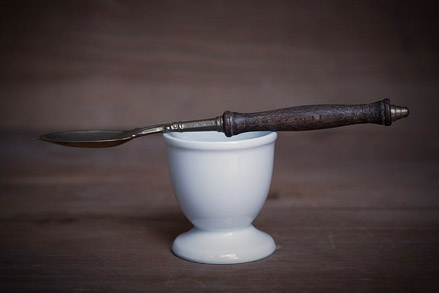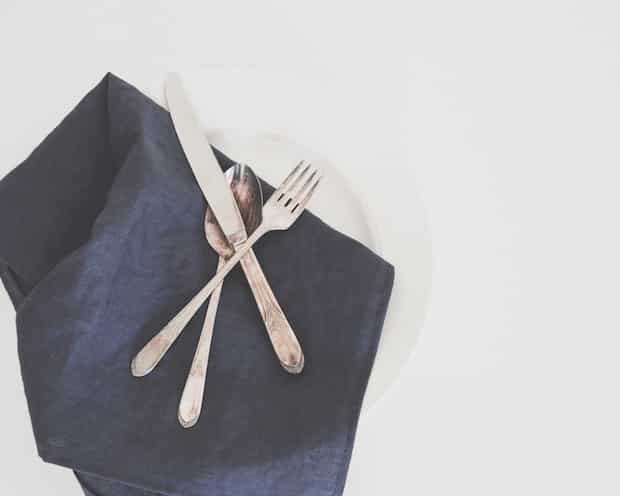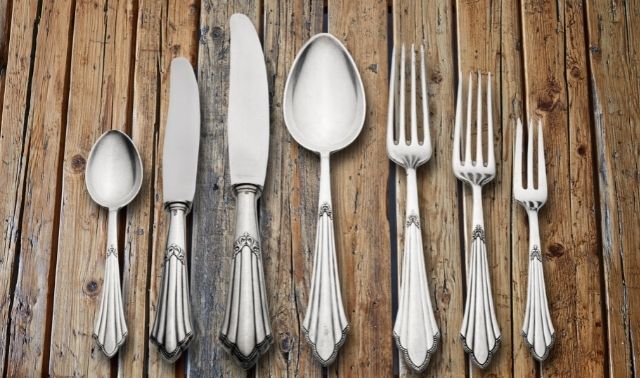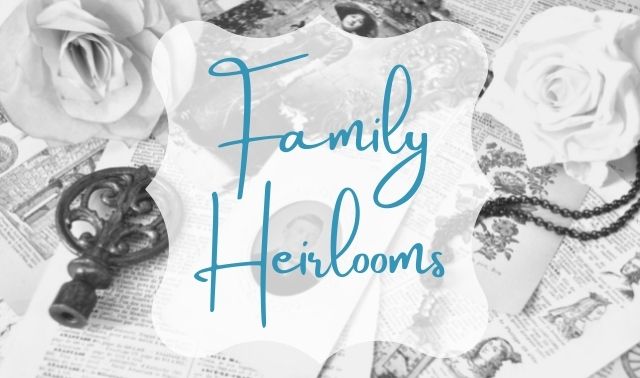Sign up for the Family Tree Newsletter! Plus, you’ll receive our 10 Essential Genealogy Research Forms PDF as a special thank you.
Get Your Free Genealogy Forms
"*" indicates required fields
There’s no debate about our ancestors’ earliest means of transporting food into their mouths: They simply used their hands. In the development of actual cutlery, however, the question is: Which came first, the knife or the spoon?
Cutting Cutlery
Knives, in the form of sharpened flints and other stones, were among humanity’s earliest tools, but served more as weapons than implements for eating. Primitive blades date to the Paleolithic period, and by Neolithic times (5000 to 2000 BC), stone blades were fitted to wooden handles. Metal knives much like today’s, with bolster and tang attaching the handle to the blade, soon followed. Iron knives showed up around 1000 BC.
Spoons were initially fashioned from shells or animal horns; our ancient ancestors attached a stick for longer reach. Spoons also were carved from wood; the word spoon comes from the Anglo-Saxon spon, meaning “a chip of wood.” The Romans made spoons from bone, pewter, bronze and silver, gradually tapering the handle end and flaring the front.
In Britain, Viking and Saxon invaders introduced leaf-shaped spoon bowls with decorative acorn carvings on the handle ends. Cromwell and the Puritans gave the spoon its present shape, removing such decorations and flattening the end of the handle while making the bowl more elliptical.
Knives and spoons were both part of a traveler’s kit; hosts were not expected to provide cutlery for their dinner guests. And as late as the Middle Ages, common people still ate with their hands, using four-day-old pieces of bread called “trenchers” to push their food. The wealthy used utensils as much to impress as for practicality. Men ate with their personal knives (also handy in case of a dinnertime dispute) and cut the food for their ladies. Presaging the development of the fork, diners would sometimes employ two knives, one to stab the food and another to slice.
Fork It Over
The fork, at least in a two-pronged design, was known to ancient peoples in forms ranging from forked twigs to Neptune’s trident. The word derives from the Latin furca, for pitchfork. Ceremonial forks were used in Egyptian religious rites, and the Greeks had “flesh-forks” to remove meat from boiling pots. But the idea of the fork as tableware didn’t become popular until about 400 AD in the Middle East.
One tale of the introduction of the fork to Western Europe credits Maria Argyropoulina, the Greek niece of Byzantine Emperor Basil II, who brought a case of golden forks to Venice in 1004, when she was to be married to the son of the Doge. She shocked guests at the wedding feast by using a fork, leading one priest to comment, “God in his wisdom has provided man with natural forks—his fingers. Therefore it is an insult to Him to substitute artificial metal forks for them when eating.” Italian clerics viewed it as God’s vengeance when Argyropoulina died of the plague two years later.
Nonetheless, the fork began to make inroads. A “suckett” fork was sometimes used to eat fruits in syrup or other messy foods. (Courtesans were said to be especially fond of such forks, sparking further clerical condemnation.) Catherine de Medici popularized forks in France when she brought them back from Italy in 1533 upon her marriage to the future Henry II.
But forks remained a Continental affectation. In 1611, Englishman Thomas Coryat published an account of his adventures across the Channel, Coryat’s Crudities: Hastily Gobled up in Five Moneths Travells (available online at Internet Archive), in which he described how Italians “at their meales use a little forks when they cut the meats.” In 1616, English playwright and satirist Ben Jonson made fun of the fashion of using forks for “the sparing of napkins” in The Devil Is an Ass.
Forks may have inspired derision in part because they didn’t work well. Food fell off two-tined forks, slipping through the gap. Curving the business end of the fork and adding a third tine—and, in Germany by the early 1700s, a fourth—gave the utensil the shape we’re familiar with today.

The Great Divide
It was a change in the table knife, however, that put forks at every place—and forever separated how Americans and Europeans eat. Cardinal Richelieu of France supposedly was so disgusted by a frequent dinner guest’s habit of picking his teeth with his knife that he had the tips of the man’s knives ground down. The fashion-conscious French court picked up on this style and followed suit.
In 1699, to reduce the risk of dinnertime knife fights, French King Louis XIV banned pointed knives outright. Since blunted knives were useless for spearing food in the old two-knife dining style, forks replaced the knife held in the left hand.
The newfangled blunt knives reached the American colonies in the early 1700s, where few forks were available. Americans were forced to use upside-down spoons to steady food for cutting. They would then switch the spoon to the right hand, flipping it to use as a scoop. Even after forks became everyday utensils, this “zigzag” style (as Emily Post called it in the 1920s) continues to divide American eaters’ customs from the Continental style of dining. (Shifting the fork to the right hand after cutting is considered uncouth by Europeans.)
By the mid-1800s, not only was the fork on every proper table, but specialized forks of every type had proliferated: forks for fish, berries, cakes, even cucumbers.
Though we still refer to “silverware,” the invention of stainless steel in 1913 eventually made a wide variety of eating utensils available to households of modest means. By adding chromium to carbon-steel, Englishman Henry Brearley revolutionized the cutlery industry. Steel utensils no longer had to be immediately washed and dried to ward off rust.
Tools of the Trade
The history of cutlery took a different direction in Asia, where the first chopsticks were developed in China around 3000 BC. Essentially extensions of the fingers, chopsticks gained the upper hand with a boost from Confucius, a vegetarian, who taught, “The honorable and upright man keeps well away from both the slaughterhouse and the kitchen. And he allows no knives on his table.”
It became easier to follow that dictum when Chinese cooks responded to scarce resources in the sixth century by cutting meat into small pieces to cook faster (saving fuel) and stretch ingredients. Soon the use of chopsticks spread to Japan, Korea and Vietnam.
Even today, however, not everyone falls into either the knife-and-fork or chopsticks camp. Some people in Arab countries, India, the Arctic and parts of Africa still eat with mankind’s original utensils—our hands.

Timeline of Cutlery History
1st century Romans develop two types of spoons: one for soups and soft foods, and one for shellfish and eggs
1006 Fork user Maria Argyropoulina dies of the plague; clergy rejoice
1533 Catherine de Medici popularizes forks in France
1608 Thomas Coryate becomes one of the first Englishmen to use a fork
1633 Charles I of England says, “It is decent to use a fork”
1669 Louis XIV of France bans pointed knives
Early 1800s Forks, sometimes called “split spoons,” catch on in America
1908 Patent issued for a fork-spoon hybrid: the spork
1924 Modern “austenitic” stainless steel developed
Adapted from the March 2011 issue of Family Tree Magazine.








